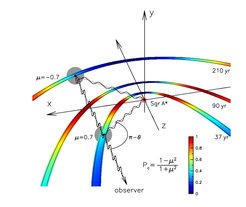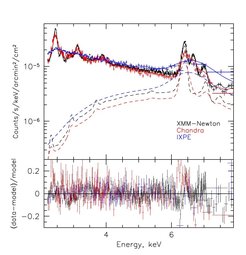200 years-old flare of Sagittarius A* confirmed by X-ray polarization measurements
Thirty years ago, astronomers realized that the X-ray emission from giant molecular clouds might in fact be the reflection of a powerful flare from the supermassive black hole Sagittarius A* at the center of our Milky Way that happened a few hundred years ago. Theory predicts several unique features of such X-ray emission, including a hard spectrum with a bright iron fluorescent line, apparent superluminal motions, and polarization of the continuum. All but polarization had been detected over the past 30 years by many X-ray observatories. X-ray polarization was lagging behind for a good reason – there were no X-ray polarimetric missions sensitive enough to address this problem. Until recently…
Molecular clouds are cold. You do not expect to see X-rays from them. Yet, in the 1990s, the GRANAT and ASCA observatories revealed diffuse, hard X-ray emission that was correlated with the distribution of molecular gas in the central region of our Milky Way. The shape of the X-ray spectrum resembled that of reflected emission in Active Galactic Nuclei (AGN) or X-ray binaries. There, a relatively cold accretion disc is illuminated by the bright central source powered by matter falling onto a black hole. This reflected emission typically consists of a very hard continuum due to Compton scattering and a bright iron fluorescent line – exactly what was seen from the clouds.

However, in our galactic center there is no X-ray source bright enough to power the X-ray emission from the molecular clouds – at least today. Therefore, scientists conjectured that there must have been a bright source in the past, a few hundred years ago. The supermassive black hole at the center of our galaxy, Sagittarius A*, is a prime candidate for such a source. While Sgr A* is currently very dim in X-rays, it might produce a million times more X-rays if it is fed with more gas. Such a flare, lasting even just a few hours, could be sufficient to explain all the clouds’ emission observed today.
An immediate consequence of the reflection scenario is the possibility of apparent superluminal motions, where an illuminated spot on the surface of a cloud seems to move faster than the speed of light. Very soon, the Chandra and XMM-Newton observatories detected such apparently superluminal motions.
A further direct prediction is the polarization of the reflected continuum emission even if the illuminating radiation is not polarized. The degree of polarization is sensitive to the scattering angle, while the orientation of the polarization plane is perpendicular to the direction towards the primary source. Therefore, if observed, one can not only provide a final proof of the nature of the molecular clouds’ X-ray emission but also verify if the primary emission came from the direction of Sgr A* and determine the age of the flare (as illustrated in Fig.1).

It took some 20 years before such polarization observations became possible. Until recently, the only secure polarization measurement was that of the Crab Nebula with the OSO 8 graphite crystal polarimeters made some 45 years ago. IXPE is a new type of imaging polarimeter that relies on the photoelectric effect – tracking the trajectory of photoelectrons in a position-sensitive detector. This new technology provides the necessary great boost in sensitivity to detect faint diffuse emission from the galactic center molecular clouds.
The first IXPE observations of the galactic center region were performed in February and March 2022. Almost simultaneously, the Chandra observatory looked at the same region. Both images (Fig. 2) show the characteristic reflection spectrum. The galactic center environment is complicated and many different components contribute to its X-ray emission. The contribution of the reflected component is relatively modest compared to the total spectrum (see Fig.3).

What IXPE adds to previous Chandra and XMM-Newton data? It verifies that this emission is polarized! The analysis of the polarized signal showed that the degree of polarization is 31±11%. This fixes the scattering angle and therefore the age of the flare: some 200 years ago. At the same time, the polarization direction is consistent with the position of Sgr A* within the uncertainties.
Thus, the IXPE data strengthen the hypothesis that Sgr A* is the primary source powering the reflection from the molecular clouds. This provides a new but long-anticipated “polarized” view on the X-ray-illuminated clouds and a complementary way of studying the energy release of our supermassive black hole in the recent past.
While the current IXPE result is already a remarkable success, many questions remain. Among them: Was it a single flare or multiple flares? Was the primary emission polarized or not? More IXPE observations are already planned that will help finding answers. Moreover, there is the truly exciting possibility that current imaging and future high spectral resolution X-ray missions will reveal the internal structure of the molecular clouds.
About the IXPE mission
Part of NASA’s Small Explorer mission series, IXPE launched on a Falcon 9 rocket from NASA’s Kennedy Space Center in Florida in December 2021. The mission is a partnership between NASA and the Italian Space Agency, with partners and science collaborators in 13 countries. Ball Aerospace, headquartered in Broomfield, Colorado, manages spacecraft operations.














